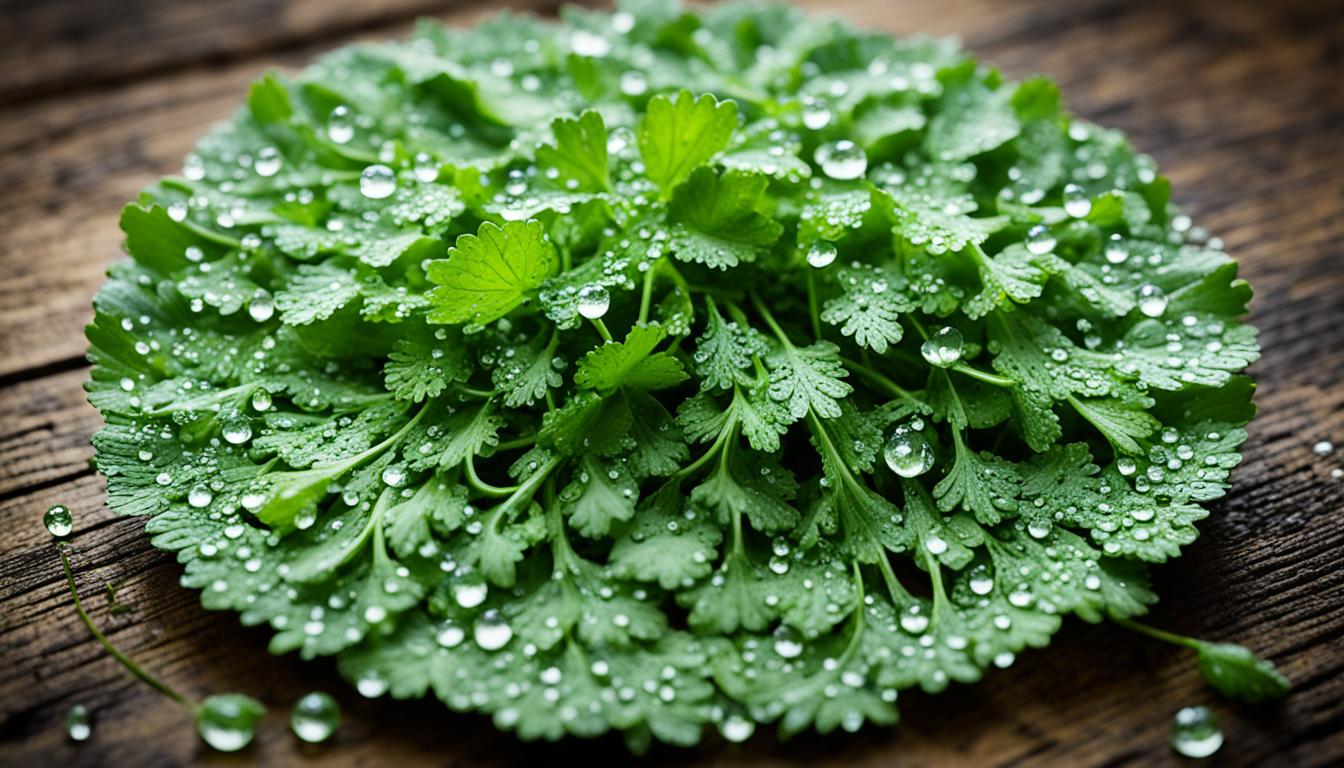Coriander is a key spice in my kitchen. It has a flavor that fits many dishes. Its taste is a mix of citrus, curry, and earthiness.
This makes it great with many flavors. It can make fruits and veggies taste better. Coriander is also used in sweet treats, showing its wide use.
Its story goes back to biblical times and has spread around the world. This makes coriander a top choice for adding flavor to food.
The Unassuming Yet Indispensable Spice
Coriander might look simple, but it’s a key spice in cooking. It has a rich flavor that goes beyond what you might think. The taste ranges from a sweet, musky smell to a hint of citrus and earthy notes. It tastes like butter and thyme too.
How you prepare coriander changes its flavor. Whole seeds give a light, sweet taste. Ground seeds have a deeper, nutty flavor.
Coriander’s Multifaceted Flavor Profile
Coriander’s taste is a mix of many flavors. Whole seeds taste floral and sweet with a hint of citrus. Ground coriander is earthier, with a nutty flavor.
This makes coriander perfect for many recipes. It’s great for what’s the difference? and global recipes featuring coriander as the star ingredient.
The Versatility of Coriander in Preparation Methods
How you prepare coriander changes its taste. Adding whole seeds to slow-cooked dishes infuses the dish with a gentle flavor. Ground coriander adds a deeper taste when used as a seasoning.
Coriander can also be added as a finishing touch. It brings a fresh, herbaceous flavor to dishes.
“Coriander’s flavor profile is hard to pin down, ranging from a sensual musk punctuated by citrus notes to an earthy scent made civilized by hints of butter and thyme.”
Coriander: A Friendly Companion to Various Flavors
Coriander is a star in global recipes. It’s great at making many flavors work well together. It adds a special touch to dishes, from spicy chiles to cool citrus.
Coriander is amazing with lentils in daal recipes. It brings out the nutty taste of these legumes. It also makes meats like lamb and chicken taste better, especially when slow-cooked.
Coriander never takes over in a dish. Instead, it adds depth that makes flavors pop. It’s a great match for many recipes that highlight coriander.
“Coriander is the unsung hero of the spice world, quietly elevating the flavors of countless dishes without ever stealing the spotlight.”
Coriander’s Global Versatility
- Rounds out the heat of chiles with its earthy, lemony notes
- Enhances the sweetness and tropical flavors of citrus fruits
- Lends depth and richness to lentils and other legumes
- Pairs beautifully with a variety of meats, from lamb to poultry
| Flavor Pairing | Dish Example | Coriander’s Contribution |
|---|---|---|
| Chiles | Thai Red Curry | Balances the heat with its earthy, lemony notes |
| Citrus | Moroccan Orange Salad | Enhances the sweetness and tropical flavor of the oranges |
| Lentils | Indian Daal | Lends depth and richness to the legume-based dish |
| Lamb | Lamb Tagine | Complements the rich, gamey flavor of the meat |
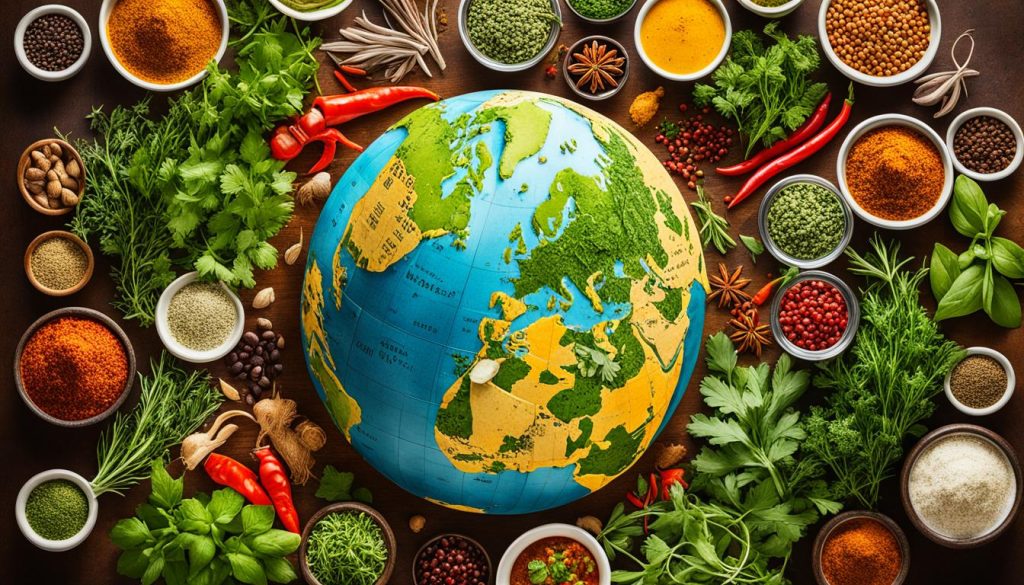
Coriander is versatile and a great addition to many dishes. It’s perfect for making a Thai curry, a Moroccan salad, or an Indian daal. This herb adds a special touch that makes food taste better.
Enhancing Fruits, Vegetables, and Other Spices with Coriander
Coriander is a versatile herb that makes many ingredients taste better. It goes well with fruits, vegetables, and other spices. Its unique taste adds depth to both savory and sweet dishes.
Coriander’s Affinity for Apples, Ginger, and Cruciferous Veggies
Coriander is great with apples, ginger, and veggies like broccoli and Brussels sprouts. It balances their flavors, making dishes taste better.
It also mixes well with spices like black pepper and cumin. Plus, it goes great with herbs like thyme and parsley. Coriander is key in curry powders and barbecue rubs, adding depth to these blends.
Adding coriander to salads, stir-fries, or marinades makes them taste better. It’s a must-have in global recipes featuring coriander as the star ingredient.
“Coriander is like a culinary chameleon, seamlessly blending with a wide array of flavors and textures to create truly remarkable dishes.”
Coriander: The Unexpected Star in Sweets
As a professional copywriting journalist, I’ve always been intrigued by the versatility of coriander. This aromatic herb is often linked with savory dishes. But, it can also surprise us in sweet treats. Its unique taste, like a mix of lemon zest and warm cinnamon, makes desserts special.
One way I love using coriander is in a whiskey-infused butterscotch topping. The herb’s citrusy taste and the sweet caramel of butterscotch make a great mix. I tried this in Pistachio Millionaire’s Shortbread and it was amazing.
| Ingredients | Quantity |
|---|---|
| Unsalted butter | 1 cup |
| Granulated sugar | 1 cup |
| Light brown sugar | 1 cup |
| Heavy cream | 1 cup |
| Whiskey | 1/4 cup |
| Ground coriander | 2 teaspoons |
| Pistachio shortbread | 1 batch |
Coriander adds a subtle kick to desserts, making them better. The mix of buttery shortbread, rich butterscotch, and coriander is divine. Coriander might not be usual in sweets, but it’s a gem in the baking world.
As we explore global recipes featuring coriander as the star ingredient, I’m excited to share more ways to use this herb in desserts. Stay tuned for more sweet surprises!
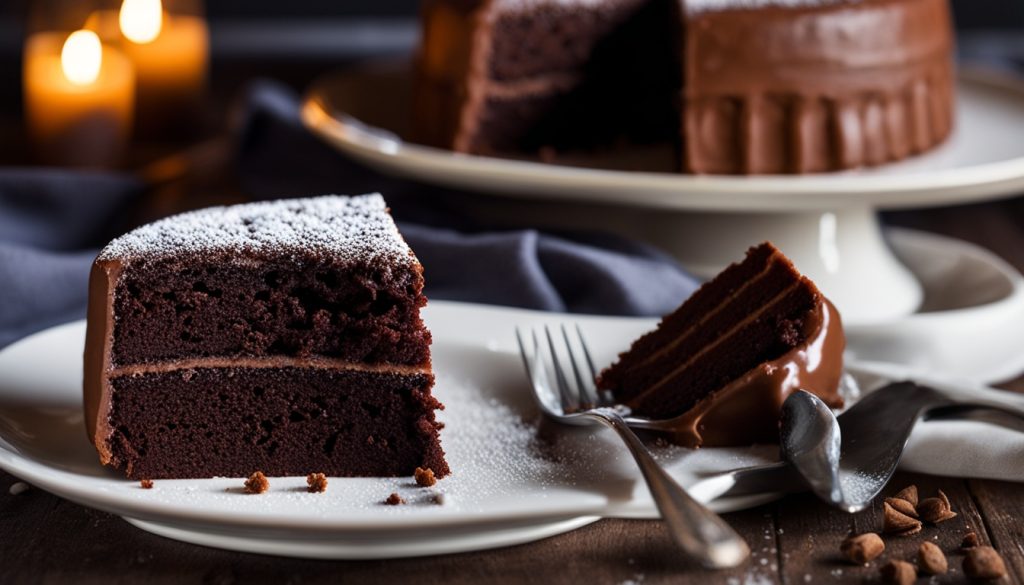
Coriander’s Global Culinary Journey
Coriander’s history is a bit of a mystery, but its role in cooking goes way back. The Book of Exodus talks about manna that looked like coriander. This shows how important coriander has been in many cuisines over time. Now, it’s a key spice in kitchens all over the world.
Coriander’s Biblical Origins and Global Spread
Coriander has traveled from the Middle East to Asia, Europe, and more. It has made a big impact on food everywhere. Its unique taste and smell are found in many dishes, like barbecue sauces and curry powders.
This shows how well coriander fits into different recipes. Chefs and home cooks love using it to make their dishes special.
| Region | Coriander-Infused Dishes |
|---|---|
| Middle East | Tabbouleh, Shakshuka, Lamb Kofta |
| Asia | Thai Red Curry, Indian Chutneys, Vietnamese Pho |
| Europe | German Potato Salad, Italian Pesto, Spanish Paella |
| North America | Barbecue Sauces, Chili Powders, Guacamole |
Coriander’s story from the Bible to today’s kitchens is fascinating. It shows how well it can adapt and add flavor to dishes. As people keep finding new ways to use coriander, its future in global cooking looks very bright.
The Cilantro Connection: Leafy Sibling of Coriander
The coriander plant gives us two spices: coriander and cilantro. They come from the same plant but taste very different. This shows how versatile this plant is.
Coriander seeds have a smooth, sweet taste with a slight sharpness. It’s loved in many cuisines around the world. Cilantro, on the other hand, has a complex taste. It tastes like pepper, sage, and citrus, making any dish better.
The what’s the difference? between coriander and cilantro is their taste and how we use them. Coriander goes well with savory foods. Cilantro is great in fresh salads, salsas, and even desserts.
| Coriander | Cilantro |
|---|---|
| Smooth, sweet, and slightly sharp | Bright, herbaceous, and refreshing |
| Commonly used in savory dishes | Versatile, used in both savory and sweet dishes |
| Earthy, warm notes | Hints of pepper, sage, and citrus |
If you love coriander or cilantro, the coriander plant has much to offer. Learning the what’s the difference? between these spices can open up new flavors. It can also help you try new things with this amazing plant.
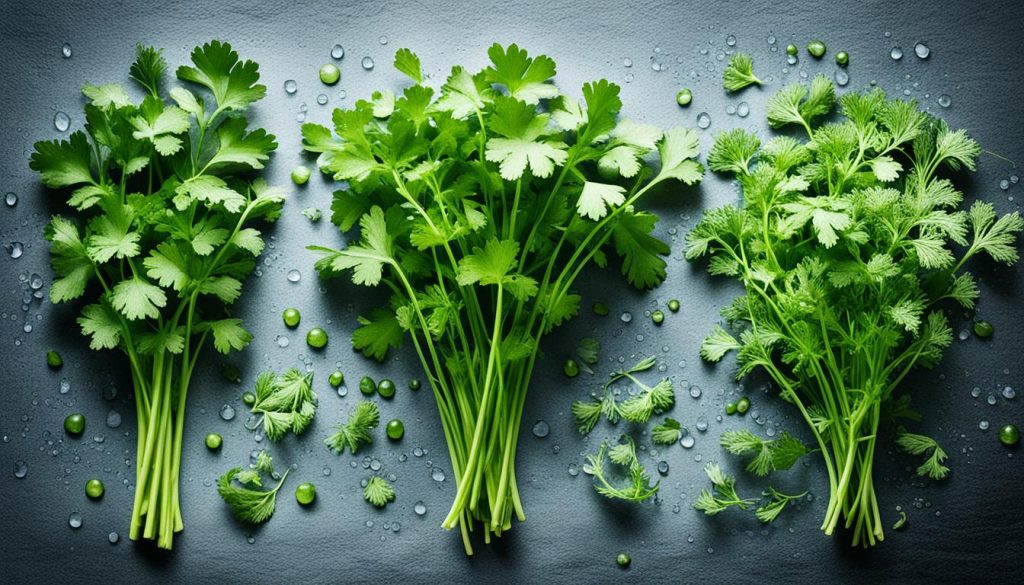
Cooking with Coriander: Tips and Tricks
Adding coriander to your cooking can make a big difference. But, it’s important to know when to add it for the best flavor. I’ve learned that coriander’s unique taste can fade if you add it too early.
When to Add Coriander for Maximum Flavor
Coriander’s flavors are delicate and can fade quickly. I suggest adding it near the end of cooking. This way, it keeps its strong taste and aroma.
Also, try toasting and grinding the coriander seeds before using them. This brings out a warm, nutty flavor. It’s great in curries, stews, baked goods, and dressings.
| Coriander Addition Timing | Flavor Impact |
|---|---|
| Early in cooking | Coriander flavor diminishes |
| Towards the end of cooking | Coriander flavor is maximized |
| Toasted and ground before adding | Develops a warm, nutty “what’s the difference?” profile |
Learning when and how to use coriander can take your cooking to the next level. Try different ways and see how it changes your dishes. Coriander can add amazing flavors to your food.
Health Benefits of Coriander
Coriander is more than just a tasty spice. It has many health benefits that go beyond its flavor. It may help fight inflammation, act as an antioxidant, and even help manage diabetes. This makes it a great choice for a healthy diet.
Coriander’s health perks come from its essential oils and special compounds. These can help with digestion and might lower cholesterol. Adding coriander to your food can taste great and boost your health.
Coriander is not just good in the kitchen. It’s also great for your health. If you want to spice up your meals or eat healthier, coriander is a smart pick. It can make your food taste better and keep you healthy.
The Antioxidant Power of Coriander
Coriander is full of antioxidants. These are important for fighting off bad free radicals and protecting your cells. This could help reduce inflammation and fight infections, making it a good choice for a healthy diet.
Coriander and Digestion
- Coriander’s essential oils may soothe the digestive system. This can help with bloating, gas, and indigestion.
- Its special compounds might help make digestive enzymes. This aids in breaking down and absorbing nutrients.
- Adding coriander to your meals can be tasty and good for your digestion.
Cholesterol-Lowering Potential
Research shows coriander could help with cholesterol levels. Its active parts might lower bad cholesterol and raise good cholesterol. This is good for your heart.
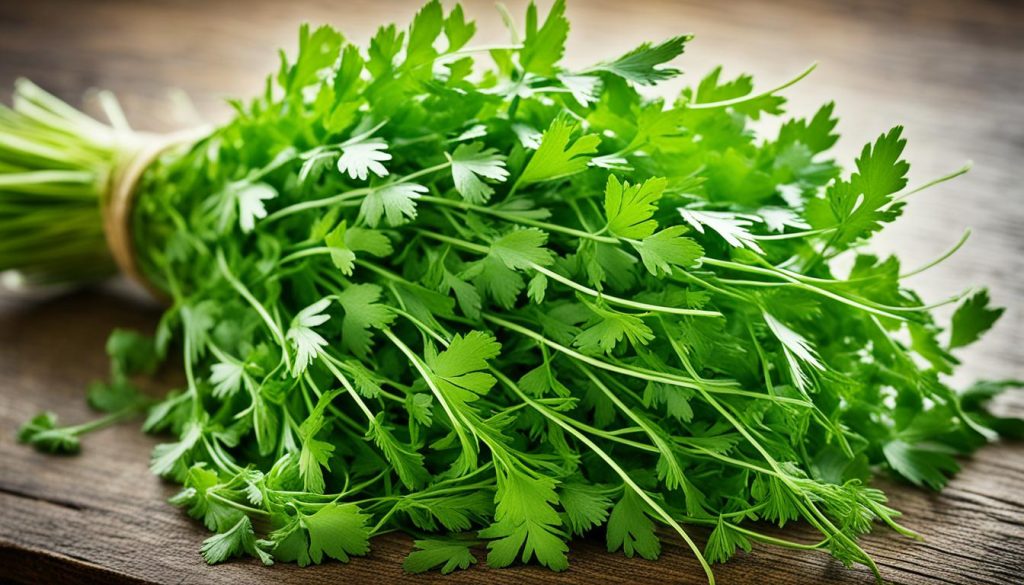
Coriander is a versatile herb that not only adds flavor to our dishes but also offers a range of potential health benefits. By incorporating this unassuming spice into our meals, we can enjoy the taste while potentially supporting our overall well-being.”
Pistachio Millionaire’s Shortbread with Coriander Butterscotch
This week’s recipe adds a twist to the classic millionaire’s shortbread. It highlights coriander as a key ingredient in global recipes. The pistachio shortbread is topped with rich butterscotch that includes coriander. This mix of flavors will make your taste buds happy.
Coriander brightens and deepens the buttery taste of the shortbread. Its unique kick makes the dessert stand out. It gives the dish a special touch that’s different from usual sweets.
To make this recipe, you’ll need a few ingredients:
- Pistachio nuts, finely chopped
- Butter, sugar, and flour for the shortbread base
- Heavy cream, brown sugar, and coriander seeds for the butterscotch topping
- A splash of whiskey to enhance the depth of flavor
Here’s how to make this treat:
- Mix pistachios, butter, sugar, and flour for the shortbread. Bake until it’s golden.
- Simmer heavy cream, brown sugar, and coriander seeds in a saucepan. Let the flavors blend.
- Add whiskey to the butterscotch for a deeper taste.
- Put the butterscotch over the shortbread. Let it set before serving.
This dessert is a unique treat that shows off coriander’s versatility. Enjoy the pistachio, buttery shortbread, and coriander butterscotch mix in every bite.
| Ingredient | Quantity |
|---|---|
| Pistachio nuts, finely chopped | 1 cup |
| Butter | 1 cup |
| Sugar | 1/2 cup |
| Flour | 2 cups |
| Heavy cream | 1 cup |
| Brown sugar | 1/2 cup |
| Coriander seeds | 2 tablespoons |
| Whiskey | 2 tablespoons |
Exploring Global Recipes Featuring Coriander
As I explore global foods, I’m always surprised by coriander’s versatility. This spice can change the taste of dishes from all over the world. It adds a unique smell and flavor. Whether it’s in an Indian curry, a Thai chicken dish, or a Mexican salsa, coriander is a key ingredient.
In Marrakech’s markets and Mexico City’s kitchens, coriander is a staple. In North African tagines, it goes well with warm spices and meats. In Latin American dishes, it adds a fresh, citrusy taste that balances rich flavors. Even in desserts, like the coriander-infused baklava I tried, it adds something special.
I’m always finding new ways to use coriander in my cooking. I like to use whole seeds in roasted vegetables or chop fresh leaves for soups. Coriander has become a must-have in my kitchen. With it, I’m ready to try new flavors from around the world.

